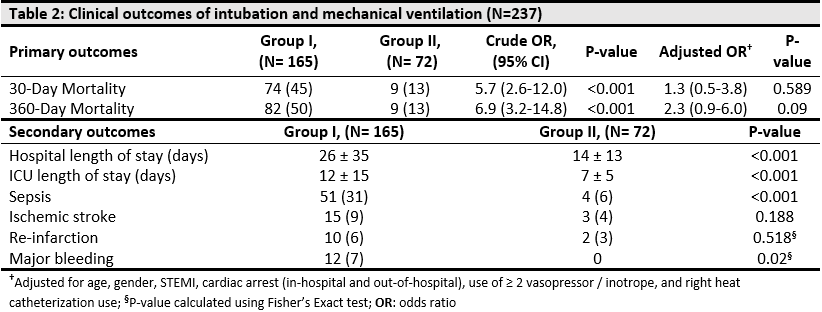Lots of interesting abstracts and cases were submitted for TCTAP 2024. Below are the accepted ones after a thorough review by our official reviewers. Don’t miss the opportunity to expand your knowledge and interact with authors as well as virtual participants by sharing your opinion in the comment section!
TCTAP A-047
Outcomes of Mechanical Ventilation in Patients With Cardiogenic Shock Requiring Intra-Aortic Balloon Pump: A 10-Year Retrospective Data Review
By Khaled Al Khodari, Alaa Rahhal, Mohammed Awad Ashour, Raad Tahtouh, Eman Shehada, Wael Kanjo, Abdelaziz M Tawengi, Mohamed Mahmoud Tawengi, Mohamad Fael, Nourelhuda Issa, Abdul Rahman Arabi
Presenter
Khaled Al Khodari
Authors
Khaled Al Khodari1, Alaa Rahhal1, Mohammed Awad Ashour1, Raad Tahtouh1, Eman Shehada1, Wael Kanjo1, Abdelaziz M Tawengi2, Mohamed Mahmoud Tawengi2, Mohamad Fael1, Nourelhuda Issa1, Abdul Rahman Arabi1
Affiliation
Hamad Medical Corporation, Qatar1, Qatar University, Qatar2
View Study Report
TCTAP A-047
Cardiogenic Shock
Outcomes of Mechanical Ventilation in Patients With Cardiogenic Shock Requiring Intra-Aortic Balloon Pump: A 10-Year Retrospective Data Review
Khaled Al Khodari1, Alaa Rahhal1, Mohammed Awad Ashour1, Raad Tahtouh1, Eman Shehada1, Wael Kanjo1, Abdelaziz M Tawengi2, Mohamed Mahmoud Tawengi2, Mohamad Fael1, Nourelhuda Issa1, Abdul Rahman Arabi1
Hamad Medical Corporation, Qatar1, Qatar University, Qatar2
Background
Limited knowledge exists regarding the influence of mechanical ventilation (MV) on the clinical outcomes of patients admitted with acute myocardial infarction (AMI) complicated by cardiogenic shock (AMI-CS) and necessitating intra-aortic balloon pump (IABP) insertion. While there is a theoretical anticipation of elevated in-hospital mortality, there is an assumed benefit of MV in enhancing oxygenation and tissue perfusion. Consequently, we undertook a retrospective cohort study to assess the outcomes linked with MV in cases of AMI-CS.
Methods
This retrospective observational cohort study was conducted at the main tertiary cardiology center in Qatar, encompassing patients admitted with acute myocardial infarction complicated by cardiogenic shock (AMI-CS) necessitating intra-aortic balloon pump (IABP) insertion from January 2012 to December 2021. The cohort was stratified into two groups: group I comprising intubated AMI-CS patients and group II encompassing those without mechanical ventilation (MV).We evaluated mortality rates at 30 and 360 days, along with the total and intensive care unit (ICU) length of stay and the incidence of complications such as sepsis, ischemic stroke, and major bleeding. Logistic regression was employed to ascertain the significance of the findings, reported as adjusted odds ratios (aOR), with a p-value < 0.05 considered indicative of statistical significance.
Results
During the study period, we enrolled 237 patients admitted with acute myocardial infarction complicated by cardiogenic shock (AMI-CS) requiring intra-aortic balloon pump (IABP) insertion. The majority were male (93%) and of Asian descent (75%), with a mean age of 54 ± 11 years. Of these, 165 (70%) patients were intubated, and nearly half of them (52%) remained under mechanical ventilation beyond the initial 72 hours of hospital admission.Comparatively, intubated patients exhibited greater illness severity than non-intubated counterparts, as evidenced by higher lactic acid levels (5.9 ± 4.4 mmol/liter vs. 3.3 ± 2.4 mmol/liter, p-value < 0.001) and a lower average pH (7.2 vs. 7.3, p-value < 0.001) in group I compared to group II patients, respectively. Among mechanically ventilated patients, 65% required the use of two or more inotropes and/or vasopressors, a necessity observed in less than half of group II patients. Cardiac arrest was present in 82% of group I patients compared to 26% in group II patients (p-value < 0.01). Table 1 provides a summary of the baseline characteristics between the two groups.Mechanically ventilated patients experienced significantly prolonged total and ICU hospital stays compared to non-intubated subjects (26 ± 35 days and 12 ± 15 days vs. 14 ± 13 days and 7 ± 5 days, respectively, p-value < 0.001). Although 30 and 360-day mortalities were significantly higher in patients requiring mechanical ventilation, adjusted mortality through multivariate analysis did not show a significant increase in intubated versus non-intubated patients at 30 days (adjusted odds ratio [aOR] = 1.3, 95% confidence interval [CI] = 0.5-3.8, p-value = 0.589) and 360 days (aOR = 2.3, CI = 0.9-6.0, p-value = 0.09), respectively. Further clinical outcomes are summarized in table 2.




Conclusion
Even though mechanically ventilated patients were in a more critical condition, the adjusted mortality was not significantly elevated compared to non-intubated patients. A cautious approach with a low threshold for intubation and mechanical intubation is advisable for hemodynamically unstable patients admitted for acute myocardial infarction complicated by cardiogenic shock and requiring intra-aortic balloon pump insertion.

